Text Solution
Verified by Experts
The correct Answer is:
|
Topper's Solved these Questions
ELASTICITY, SURFACE TENSION AND FLUID MECHANICS
ALLEN |Exercise Exercise 4 A (Surface Tension)|5 VideosView PlaylistELASTICITY, SURFACE TENSION AND FLUID MECHANICS
ALLEN |Exercise Exercise 4 A (Fluid Statics)|13 VideosView PlaylistELASTICITY, SURFACE TENSION AND FLUID MECHANICS
ALLEN |Exercise Exercise 3 (Comprehension based questions)|23 VideosView PlaylistCENTRE OF MASS
ALLEN |Exercise EXERCISE-V B|19 VideosView PlaylistERROR AND MEASUREMENT
ALLEN |Exercise Part-2(Exercise-2)(B)|22 VideosView Playlist
Similar Questions
Explore conceptually related problems
Knowledge Check
Similar Questions
Explore conceptually related problems
ALLEN -ELASTICITY, SURFACE TENSION AND FLUID MECHANICS-Exercise 4 A (Elasticity)
- In the figure shown the straing versus stress graph for two values of...
04:24
|
Playing Now - Two different types of rubber are found to have the stress-strain curv...
04:31
|
Play - The maximum stress that can be applied to the material of a wire used ...
05:21
|
Play - Two wires of diameter 0.25 cm, one made of steel and other made of bra...
07:06
|
Play - A steel rope has length L area of cross-section A young's modulus Y [d...
07:51
|
Play - If a compressive force of 3.0xx10^(4)N is exerted on the end of a 20 c...
05:36
|
Play - A light rod AC of length 2.00 m is suspended from the ceiling horizont...
08:20
|
Play
